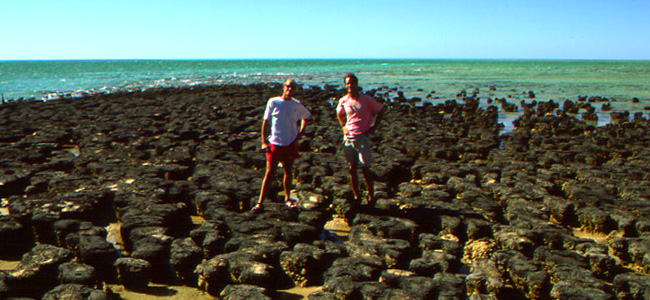
Former UCMP grad students Allen Collins (left) and Chris Meyer stand among living stromatolites in Shark Bay, at the westernmost point of Australia.
The Archean Eon and the Hadean
The Archean eon, which preceded the Proterozoic eon, spanned about 1.5 billion years and is subdivided into four eras: the Neoarchean (2.8 to 2.5 billion years ago), Mesoarchean (3.2 to 2.8 billion years ago), Paleoarchean (3.6 to 3.2 billion years ago), and Eoarchean (4 to 3.6 billion years ago).*
If you were able to travel back to visit the Earth during the Archean, you would likely not recognize it as the same planet we inhabit today. The atmosphere was very different from what we breathe today; at that time, it was likely a reducing atmosphere of methane, ammonia, and other gases which would be toxic to most life on our planet today. Also during this time, the Earth's crust cooled enough that rocks and continental plates began to form.
It was early in the Archean that life first appeared on Earth. Our oldest fossils date to roughly 3.5 billion years ago, and consist of bacteria microfossils. In fact, all life during the more than one billion years of the Archean was bacterial. The Archean coast was home to mounded colonies of photosynthetic bacteria called stromatolites. Stromatolites have been found as fossils in early Archean rocks of South Africa and western Australia. Stromatolites increased in abundance throughout the Archean, but began to decline during the Proterozoic. They are not common today, but they are doing well in Shark Bay, Australia (see photo below).
 Former UCMP grad students Allen Collins (left) and Chris Meyer stand among living stromatolites in Shark Bay, at the westernmost point of Australia. |
Hadean time (4.6 to 4 billion years ago)* is not a geological period as such. No rocks on the Earth are this old, except for meteorites. During Hadean time, the Solar System was forming, probably within a large cloud of gas and dust around the sun, called an accretion disc. The relative abundance of heavier elements in the Solar System suggests that this gas and dust was derived from a supernova, or supernovas — the explosion of an old, massive star. Heavier elements are generated within stars by nuclear fusion of hydrogen, and are otherwise uncommon. We can see similar processes taking place today in so-called diffuse nebulae in this and other galaxies, such as the Nebula M16, below left.
 |
 |
|
Left: A Hubble Space Telescope image of a star-forming region of Nebula M16 (Eagle Nebula). Right: Asteroid Ida and its moon as imaged by the Galileo spacecraft in 1993. The spacecraft was about 10,500 kilometers (6,500 miles) from the asteroid. |
||
The sun formed within such a cloud of gas and dust, shrinking in on itself by gravitational compaction until it began to undergo nuclear fusion and give off light and heat. Surrounding particles began to coalesce by gravity into larger lumps, or planetesimals, which continued to aggregate into planets. "Left-over" material formed asteroids and comets, like asteroid Ida, above right.
Because collisions between large planetesimals release a lot of heat, the Earth and other planets would have been molten at the beginning of their histories. Solidification of the molten material into rock happened as the Earth cooled. The oldest meteorites and lunar rocks are about 4.5 billion years old, but the oldest Earth rocks currently known are 3.8 billion years. Sometime during the first 800 million or so years of its history, the surface of the Earth changed from liquid to solid. Once solid rock formed on the Earth, its geological history began. This most likely happened prior to 3.8 billion years, but hard evidence for this is lacking. Erosion and plate tectonics has probably destroyed all of the solid rocks that were older than 3.8 billion years. The advent of a rock record roughly marks the beginning of the Archean eon.
Resources and references
* Dates from the International Commission on Stratigraphy's International Stratigraphic Chart, 2009.
Brian R. Speer created the original Archean page, 3/9/1997; Ben M. Waggoner created the original Hadean page, 2/20/1996; Dave Smith combined the content into a single page, adapted it to the new site format, and made some content changes, 7/7/2011; Shark Bay photo courtesy of Allen Collins (?); Nebula M16 photo courtesy of NASA, ESA, STScI, J. Hester and P. Scowen (Arizona State University); asteroid Ida photo courtesy of NASA and the JPL